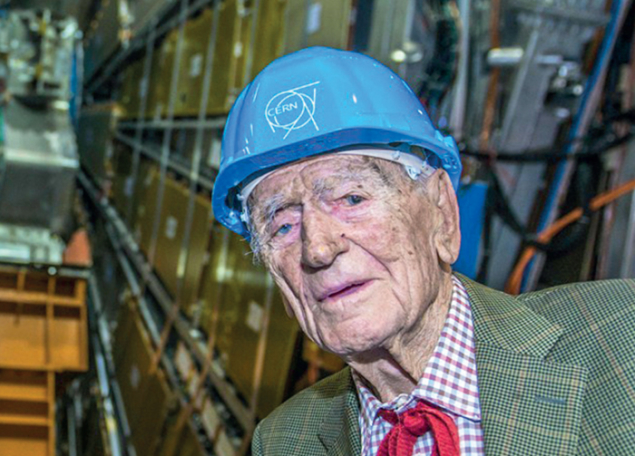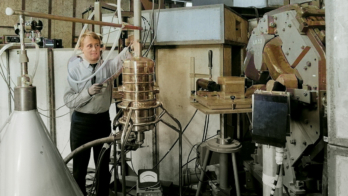
Image credit: CERN-GE-1307171 – 01.
1946 a commission of the United Nations Security Council was entrusted with the task of making proposals to bring atomic energy under international control. It was one year after the devastation of Hiroshima, and the idea of such control had been approved by all the governments. The commission was made up of influential scientists who had the knowledge that was needed to understand the problem fully and of politicians and diplomats representing the governments’ interests. It was in this capacity as a diplomat that I represented France on the commission and was able to establish trusting and friendly relations with many of my countrymen who were scientists, as well as with foreign scientists, first and foremost among whom was Robert Oppenheimer, who was to play a very important role in the creation of CERN.
In the course of the many conversations I had with Oppenheimer in the US, in which we were often joined by other Frenchmen, who were my scientific and technical advisers, he confided his worries about the future development of fundamental physics in Europe. “Almost all we know, we have learnt in Europe” is the substance of what he said. He himself had been a pupil of Niels Bohr in Copenhagen. “But in the future,” he continued, “research is going to require industrial, technical and financial resources that will be beyond the means of individual European countries. You will therefore need to join forces to pool all your resources. It would be fundamentally unhealthy if European scientists were obliged to go to the US or the Soviet Union to conduct their research.”
Early in 1950, convinced by this argument, Francis Perrin, then high commissioner for atomic energy in Paris, and I began to visit the main European research centres that would need to be persuaded. We met with a favourable response from Edoardo Amaldi in Italy, Niels Bohr in Copenhagen, Paul Scherrer in Switzerland and possibly Werner Heisenberg in Germany, if I remember correctly, but we were given a cooler reception in other capitals. Nevertheless, the idea was now on the table and was no doubt starting to take root in people’s minds. Moreover, it came on top of an appeal on similar lines from the European Centre for Culture in Geneva, led by Denis de Rougemont from Switzerland and Raoul Dautry from France. It was then that Isidor Rabi, a Nobel prize winner, made his crucial speech at the UNESCO General Conference in Florence in June 1950. Speaking on behalf of the US, he more or less said the same thing that Oppenheimer had said to us in private.
This speech marked a definite turning point, persuading the majority of European scientists and their governments to adopt a resolution authorizing UNESCO to “assist and encourage the formation and organization of regional centres and laboratories in order to increase and make more fruitful the international collaboration of scientists”. Pierre Auger, UNESCO’s director of natural sciences, took matters in hand and, at the end of 1951, managed to organize a conference of all European scientists and government representatives, which I had the honour to chair and at which it was decided to establish the European Council for Nuclear Research.
It should be realized that, in the wake of Hiroshima, people were afraid of science and of nuclear science in particular
The fundamental ideas, namely the goals that all the pioneers of what was to become CERN set themselves, consisted first of all in promoting European co-operation in this vital area. CERN was thus the first venture on a European scale and I can say that Robert Schuman, who was then French minister of foreign affairs and one of Europe’s founding fathers, was immediately in favour of it. A second goal was to reintroduce complete freedom of communication and the sharing of knowledge into this branch of science.
It should be realized that, in the wake of Hiroshima, people were afraid of science and of nuclear science in particular. “The physicists have known sin” said Oppenheimer, and the consequence of using scientists’ work for military purposes was the imposition of secrecy and the lack of communication between research centres. By immediately taking the opposite approach to fundamental research in its statutes, CERN was following the great tradition of science knowing no boundaries. The ambitions of these pioneers were more than fulfilled, since CERN is today home to scientists from all over the world, including the US, China, Japan and Russia, all working together and in teams on the same research, the results of which are published in full.
Another of my memories concerns the extension of the CERN site into France. After the construction of the 28 GeV Proton Synchrotron, it soon became apparent that, in the time-honoured fashion, this was only a scale model of more powerful machines to come. The area that Switzerland had been able to set aside for CERN could not be extended on the Swiss side. Luckily, the site ran alongside the border with France, and the land in that area was essentially being used for farming. The continuation and development of CERN’s activities were therefore dependent on extending the site into France, thus requiring a parcel of around 500 hectares of French land to be made available to an international organization with its headquarters in Switzerland. I prepared a dossier, which was submitted to the then French president, General de Gaulle, by the minister of foreign affairs, Maurice Couve de Murville. That is how CERN became – and I think remains to this day – the only research centre to straddle the border of two countries.





